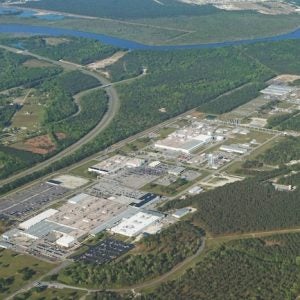Unseasonably heavy snows in the Great Plains, heavy rainfall upriver and a late snowpack melt combined to flood the Missouri river from late May through September 2011, a flood which utility Omaha Public Power District calls the longest-lasting flooding of any US nuclear power plant.
That floodwater had a disastrous effect on the site of Fort Calhoun, which is located on the bank of the Missouri near Blair, Nebraska (north of Omaha), at an elevation of about 4.5 m (15 feet) higher than the mean river level. The station, a Combustion Engineering 500MWe PWR, draws river water to cool the turbine condenser in a once-through system.
Before the arrival of the flood, in April 2011, the station shut down for a planned refuelling and maintenance outage whose scope included replacing a third of the fuel, a reactor coolant pump motor, upgrading the station’s turbine control system, replacing electronics in one of the station’s diesel generators, and maintenance on more than 600 valves. But after completing reactor core reload, operating utility Omaha Public Power District did not start the next part of the process, the engineered safety features testing, out of concern about the rising river waters. It has remained shut since.
The station had good reason to be especially cautious, after receiving two recent inspection findings by the US Nuclear Regulatory Commission. A ‘white’ finding in early 2011 of ‘low to moderate importance to safety’ had to do with an electrical component (a contactor) in the plant’s control system that failed during testing; the other, in 2010, had to do, ironically, with flood preparation (a ‘yellow’ finding of ‘substantial importance to safety’). Because the two findings’ time frames overlapped, the plant will have enhanced regulatory oversight for a 12-month period that began officially in September 2011.
Sandbagging
“We had identified during an inspection a violation, a failure to establish and maintain procedures to protect a [cooling water] intake structure and an auxiliary building during flooding,” said Victor Dricks, NRC region 4 (Western USA) senior public affairs officer. “The specification they had was a sandbagging strategy of filling and piling sandbags. When we looked at the plan and asked for a demonstration, it became clear that it wouldn’t have worked.”
“The [original] plan entailed first of all that they would have thousands of empty bags with which to fill with sand. But they had not made arrangements for any sand to be delivered on site, and they didn’t have enough sand on site to fill the sandbags. The other problem was that the strategy entailed stacking sandbags in a narrow area in a configuration that was just impossible; you couldn’t get a stable configuration high enough and deep enough to protect some doorways which were rather narrow,” Dricks said. But in response to the NRC finding, the Ft. Calhoun utility Omaha Public Power District made changes.
“Part of their solution was to make sand available. They also put in new flooding gates that could be installed in place of sandbags,” Dricks said. These actions among others altogether made up a flooding plan that put the station ‘in good shape to respond to incidents.’ OPPD said that the plan was scheduled to be reviewed by the NRC, but the flood got in the way.
On 6 June, when river water was predicted to rise above the approximate station grade (1004 ft above mean sea level), the station issued its lowest level of alert (level one), ‘notification of unusual event’. Five feet higher is the station’s technical specification shutdown level (at which point the emergency response is escalated to an alert, although OPPD says that its own procedures would shut the station before it reached this point). A further five feet higher is its design basis flood level, based on a maximum rainfall, snowmelt and dam burst scenario. Should the waters exceed the design basis flood, additional equipment would need to be deployed to provide power and supply cooling and makeup water.
To manage flooding response operations, OPPD set up an incident command structure to monitor flooding, mitigate water intrusion and assess station needs. An incident commander and logistics coordinator reported to the station’s operations shift manager. Site teams used metal floodgates to protect safety-related equipment, built an earthen berm and installed sandbags around the switchyard and other buildings, erected elevated scaffolding walkways for staff, filled temporary water barriers (‘Aqua-Dams’) to protect buildings such as the administration office, added a an extra store of diesel fuel, and installed pumps to remove any water that seeped through the dams.
A crisis broke out in the early hours of 26 June when one of the Aqua-Dams was punctured by site workers, Dricks said. Although the collapse of the berm did not affect the safety of the station, it did make it more difficult to move around the site. As a precaution, the station temporarily disconnected from grid power and moved to on-site diesel backup power while safety checks were carried out. Another berm was eventually installed, Dricks said: “They called the vendor in, who gave them assistance, and helped them reestablish a dry area around the buildings; that took several weeks.”
The flood waters peaked on 27 June at around 1007 ft above sea level. But the water did not recede sufficiently to be able to exit the notice of unusual event status until 29 August 2011. After a few meetings with the regulator, the utility submitted a formal recovery plan, which as of late November it was working through (see table 1) with the ultimate aim to restart the station. A named staff member takes responsibility for each area of the action plan, and is presenting progress in his area in fortnightly meetings with the site vice president. Closing out an issue in the document requires a formal standardised process that will be independently reviewed. Actions will also be overseen by the quality assurance department.
In some difficult-to-reach areas such as tunnels, NRC inspectors will accompany plant personnel, Dricks said. He added that OPPD will have to repair many roads, whose asphalt blacktop was damaged by submersion under the flood waters.
Author Info:
This article was originally published in the January 2012 issue of Nuclear Engineering International magazine.
Related ArticlesExelon to operate Fort Calhoun Review of units in long-term shutdown in 2011 Nuclear stations carry on despite Nebraska floods Outages at US nuclear plants hit four-year-high in Spring 2011
| Table 1: Ft. Calhoun flood recovery action plan |
|
1. Site restoration – Flooding protection and equipment demobilization – Plant and facility restoration – Bus 1B4A restoration and extent of condition actions [a breaker failure unrelated to the flooding caused a fire in the switchyard on 7 June] – 13.8 kV underground distribution damage assessment and restoration 2. Plant systems and equipment – Station fire protection system damage assessment and restoration – System health assessments – Wetted motor damage assessment and restoration 3. Long-term equipment reliability – Engineering program reviews – Underground cable assessment – Underground piping and tanks assessment – I&C power supply service life assessment 4. Design and licensing basis – Plant and facility geotechnical and structural assessment – External flooding barrier configuration – Plant design configuration control – External flooding design basis review – High energy line break remediation – Design resolution items 5. Emergency planning – Return alert notification sirens to functional status – Field monitoring and post accident environmental monitoring – Assessment of offsite emergency response following a natural disaster – Onsite facility and equipment restoration
– Security system damage assessment and restoration |






